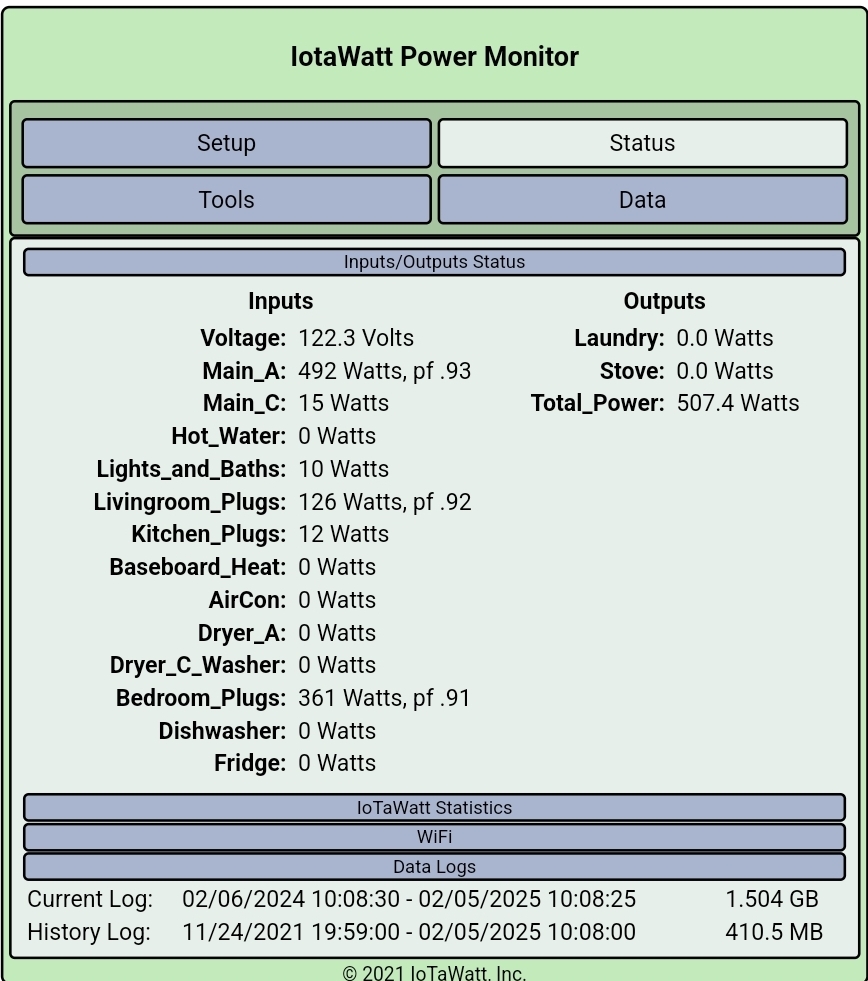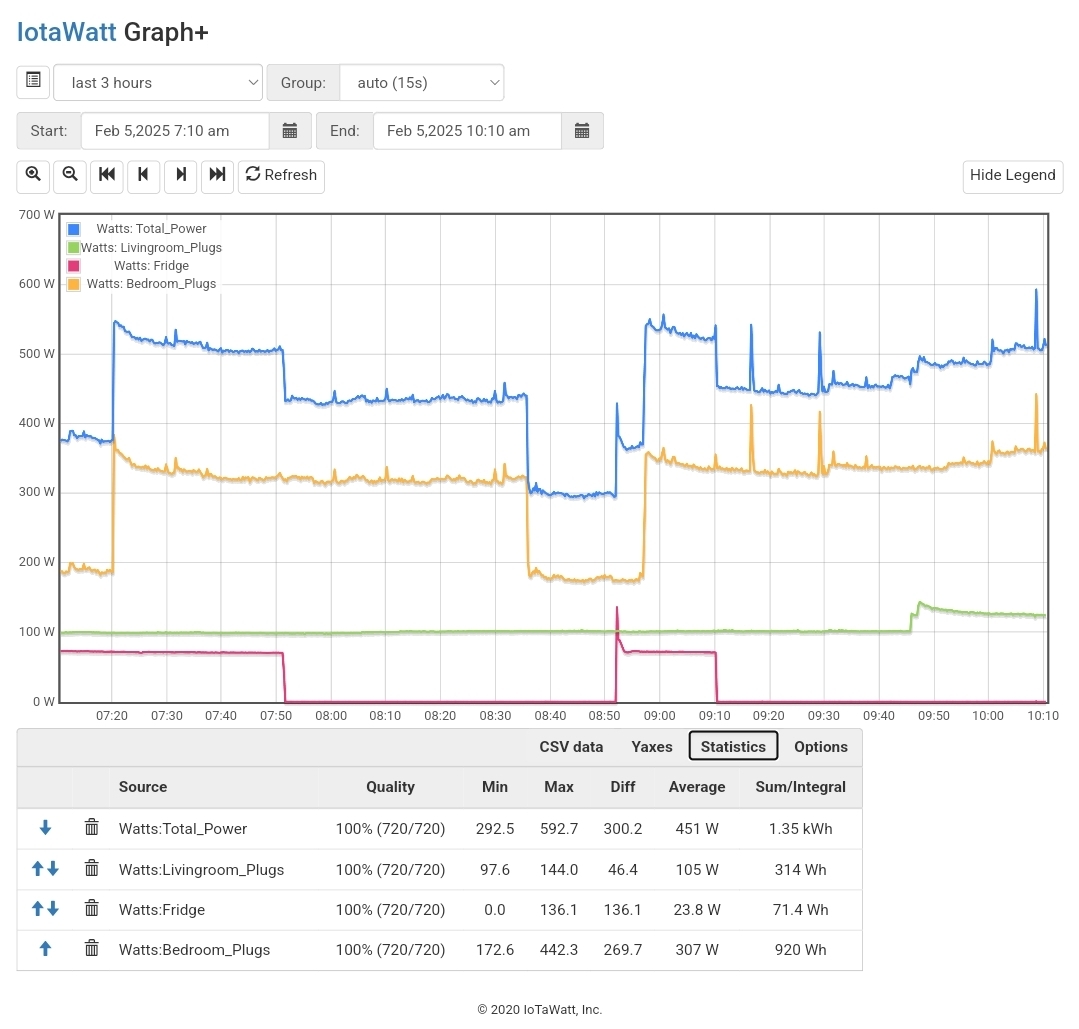I’m in the process of getting my Home Assistant environment up and running, and decided to run a test: it turns out that my gaming PC (custom 5800X3D/7900XTX build) uses more power just sitting idle, than both of my storage freezers combined.
Background: In addition to some other things, I bought two “Eightree” brand Zigbee-compatible plugs to see how they fare. One is monitoring the power usage of both freezers on a power strip (don’t worry, it’s a heavy duty strip meant for this), and the other is measuring the usage of my entire desktop setup (including monitors and the HA server itself, a Lenovo M710q).
After monitoring these for a couple days, I decided that I will shut off my PC unless I’m actively using it. It’s not a server, but it does have WOL capability, so if I absolutely need to get into it remotely, it won’t be an issue.
Pretty fascinating stuff, and now my wife is completely on board as well; she wants to put a plug on her iMac to see what it draws, as she uses it to hold her cross-stitch files and other things.
Have you considered putting your gaming pc in one of the storage freezers? /s
This game a serious chuckle… BC I deff considered it. Or keeping the box on balcony in the winter to get few more fps back in the day
A fridge can create a fairly low overall temp, but with something like a PC generating a ton of heat inside, it can’t keep up. The fridge just can’t move the heat fast enough and becomes an insulated box trapping the heat instead.
Perfect, I don’t need to run the fans anymore!
Seriously though - we have 5 kids, and feeding the little shits is expensive, so we freeze a lot of things for storage. I thought for certain the freezers would be power hogs compared to an idling PC, but I was very surprised to be proven wrong.
Next up… Measuring my server cluster 😬
Have you considered putting your children in one of the storage freezers? /s
Measuring my server cluster
Personally, I just don’t ask questions I don’t want the answer to.
I know they’re gonna be a power suck lol. Three mini PCs, a SFF PC, 4-bay hard drive docking station, 8-port switch, and a RPi0w… Hoping for a max of 200W, but I suppose we’ll see what happens 🫤
You might need to lower your expectations
FYI - the cluster is pulling 115-140 watts.
- 1x Mac mini 2014, running OMV as a dedicated NAS (i5-4308U, 16GB RAM)
- 4-bay Sabrent DS-SC4B, attached to Mac mini (3x 4TB WD Reds in RAID5, 1x 4TB WD Black as hot spare)
- 1x 8TB WD backup drive (it’s something)
- 2x HP Elitedesk 800 G3 mini (or G4, don’t remember), both running Proxmox (i7-7700T, 32GB RAM each)
- 1x Dell Optiplex 7050 SFF running Proxmox (i7-7700, 32GB RAM)
All running multiple VMs (Docker and other) and LXC containers.
I’m impressed, honestly. I was expecting 200+ watts minimum. It’ll be interesting to see the spikes as it’s used over time. I am going to move the HA server (Lenovo M710q running HAOS on a Pentium G4560T & 4GB RAM) down to the cluster soon, as it’s sitting on my desk at the moment…
I’m surprised! Seems like it should be more, but I haven’t done any wattage calculations in a while, so maybe power efficiency really has gotten that much better.
Do you know if the drives were spun up or down at the time? I know idle vs. active makes a difference, but if they were spun down entirely, that’s kind of cheating.
I see your 4-bay docking station and raise my 20-bay storage server. I even stopped counting how much the hardware costs for it :p
Lat I checked, it was 40w idle for me on the kill-o-watt. Spinny rust and all!
Last.
Speak for yourself…
Super, go on dear…
I got a UPS cause the breaker to my room likes to trip if I am gaming and someone in the house decides to microwave something for 10 minutes. My desktop, three monitors (2x1080p 60hz + a 1440p 144hz) and my 3d printer all running at full tilt will suck my 1500w UPS dry in about 2 minutes lol.
If I’m not gaming and say just watching YouTube while not 3d printing anything that same UPS can run for almost 15 minutes.
breaker to my room likes to trip if I am gaming and someone in the house decides to microwave something
… Why the hell is your pc on the same breaker as the kitchen??
The kitchen plugs should have their own dedicated breaker in most modern electrical codes (at least in North America). The voltage drop your pc experiences everytime a high-load item like a microwave or kettle is turned on, on the same circuit, is really rough on your PSU.
At least you have a UPS which presumably performs some power conditioning, but still. Not great.
That’s the best part. It’s not in the kitchen. My room is on the complete opposite side of the house. Literally the furthest room from the kitchen.
Whatever drunk moron wired the house back in the 70s did so in such a confusing manner that electricians give us the “fuck no I’m not fixing that” price when we ask them what it would cost to sort out our completely nonsensical wiring. I think the last guy we talked to quoted us 30k and he pretty much flat out told us nobody will ever want to unfuck our house.
Do everything outside the walls. I had the same problem in my house, I literally killed all the wires inside the walls and did a whole new installation in an industrial style outside the walls. It’s way better for maintenance purposes anyway.
See I would have no problem with that but the other people living in this house would have a lot of problems with that. Namely the women. I know for a fact me and the other guys would prefer it but the ladies would never green light something that “ugly” lol.
You’re in the same boat as me, except swap 70’s for 1920’s. I have to tear down all the plaster – not drywall, actual literal plaster, on lath – to get at the ground floor wiring. I decided it’s fine where it is for now.
Yeah at some point you just say fuck it and limp along until the problem is big enough that it’s time for a completely new house or you move.
In our situation it’s one of those things where it just doesn’t seem worth it to properly address because if we are gonna have an electrician cut a bunch of holes in our walls to redo all the wiring we may as well have a plumber cut a bunch of holes in our ceiling to insulate all the pipes they installed in the ceiling crawl space without any insulation. And if we have them cutting holes in every wall and every ceiling we may as we lost have them tear the whole goddamn house down and start over properly lol.
You used the magic word, “modern.”
Lots of houses in this world are not modern, and some of them are old enough that they were retrofitted to have electricity, as mine was, rather than even being built with it to begin with. And done so in a haphazard manner when electrical codes were either much more lax than now or didn’t exist. And further when the expected power draw for a household was considerably lower, because basically all of it in the 1920’s or whatever was only used for lighting and we didn’t have all of our current appliances, TV’s, computers, 3D printers, or even indoor space heaters.
So moaning about what ought to be rather than what is really doesn’t accomplish anything, especially in OP’s case.
My small house has basically the entire ground floor wired to only two 15 amp circuits.
A lot of people aren’t even aware of the concern. That’s why I bring it up.
Paying an electrician to add a breaker is much cheaper than replacing the PC. Tho that’s up to OC if they want to pursue that. I’m just putting the info out there for them to consider.
I had a similar revelation. Home assistant has a WOL component, so you can set that up for easy starts. I’ve had mixed success with mechanisms to get HA to sleep the computer, though.
Ideally I want the machine to be sleeping I’d I’m not using it.
I use Kasm for remote access, I believe that has a WOL component as well. I haven’t set it up as such, but I plan to later on.
If you get a reliable way to sleep a windows machine via MQTT (not sure if that’s a route you’d take) but I’d be super interested in hearing about it.
I use HASS.agent to help manage my Windows desktop and expose various sensors to HA. It can suspend or hibernate the system. It does use MQTT as its connectivity plane.
Oh nice, I’ll give that a shot. I was using IOTlink but the service wasn’t reliable on my machine and needed to be restarted constantly…
I’ll give HASS.agent a shot! Thanks
Do you have a link to the plugs? I want to try the same
Sure!
https://www.amazon.com/dp/B0DQTFM1T6
Just plug it in, hold the button to put it into pairing mode, then launch your zigbee discovery method. No app, no wifi, no bluetooth. Just pure local control.
Does it clock down when idle?
No idea. I would imagine it does, but that’s something I’ll need to check.
You can also test if multiple monitors is having an effect.
Using sleep mode is a good idea anyways, regardless of idle draw.
Yeah, man, getting into Home Assistant and messing with energy monitoring did more than thousands of chastising TV segments to get me to fully shut down my computers.
Who gives a crap about gaming use power consumption, give me idle benchmarks, you cowards. Do you even know how kWh work?
Plus PC that’s idling is just adding an attack surface IMHO
This tinfoil getting hella tight lately 🥲
How, if it’s not exposed to the internet? Burglars?
Do you really trust your consumer grade router and firewall on the desktop?
Against random internet noise? Yes, absolutely
What about something more spooky?
Most ISP routers have sane default settings and block all incoming traffic, you don’t even reach their log in interface. If they are somewhat updated you’ll be fine in most cases.
OK but what if you have a lava lamp that is synced to the moods of a sarcastic and greedy AI?
Security is about to get really weird. It used to be the Internet of Things we had to worry about, but now we have Things in Internet.
wtf is that 😄
But I agree, random hardware in your LAN is more of a security threat than anything coming from outside in many cases.
Yeah. I got a pro managing it.
You got a pro managing it?
\sigh
Is your gaming PC air gapped from the internet??
No. What kind of attack are you afraid of by idling a computer connected to your ISP router?
Any program on your PC that maintains or frequently initiates outbound connections, other machines on your LAN spreading an infection, literally any Trojan, etc. Double that if you haven’t disabled UPnP on your ISP router which is probably on by default.
If you are afraid of your PC infecting itself by background outbound connections, you should not turn it on at all. Running 24h vs 6h a day barely makes a difference in this regard - yes, there are fewer “random internet noise attacks” in less hours, but if your LAN is that dangerous, the computer should not be on for 5 minutes. Either you trust your LAN enough to have a computer running, or not.
Double that if you haven’t disabled UPnP on your ISP router which is probably on by default.
Talking about the sane defaults I mentioned earlier - my router has it off as a default. But if it wasn’t, my approach wouldn’t be to turn devices off¹ but change the router setting.
¹ I actually do turn off/plane mode all my non-server devices when I’m not using them but not for that reason.
You’re totally right, not turning it on at all would be safer. But we do need to use them so it makes sense to turn it on while in use. Security is only good up to the point of it making your machine unusable. Most of the attacks you see on running computers by happens overnight anyway, or otherwise when your machine is sitting idle not in use. Plus it gives you the opportunity to witness odd behavior if it were to happen while you’re using it.
And no, you should never trust your LAN in the year of our lord 2025. We are well beyond that in the cybersecurity landscape and have been for 10+ years. Zero Trust is the name of the game. If a device is on, and connected to the internet, it’s a target, as are any other devices on that network. Pretend that is not the case at
If it gets the wife approval you know you are on to something
If you want to expand from just monitoring a couple sockets to monitoring the whole house; I’d recommend Iotawatt. I’ve been using one of these to monitor every circuit in my house for a few years now.
You can use the built in webpages shown below to view it’s internal graphs, or setup an exporter to feed the data into external DBs like influxDB+Graphana or Emoncms.


Very cool! However, my house is a rental, so any monitoring equipment has to be somewhat non-invasive.
Edit: it helps if I actually look at the product before spouting nonsense… Looks promising.
I’m in a rental too. It’s non-invasive; just gotta pop the panel cover off, clip the transformers over the wires without disconnecting them, and put the cover back. It can all be removed just as easily.
just
Uh oh. Red flag.
gotta pop the panel cover off,
This may be where the rental agreement is broken. Define ‘pop’ . Two hands and a tool? Clear it with the landlord first. The company running the 400-unit building where I am now is gonna say F No.
Spaces before a full stop? Really?
Yeah, energy monitoring ruined several things for me. Can’t let my PC idle anymore, can only turn on the dishwasher when the sun is shining, need to explain regularly to my wife, why our home network and server infrastructure consume 130 Watts per hour, have to automate all plugs with standby devices connected…
The damn freezer consumes only 400 Watts per day while Network infrastructure, server, Wallpanels and KNX consume 3 Kilowatts, I wish I would have never learned this.
There is a reason people opt for old desktop CPUs and SSD’s
Part of why I’m going with the ‘T’ variant of the Pentium G4560 on my custom NAS build.
Just fyi, Watts is a measure of power, and WattHours is power over time. So your home network and server consume 130w, which would be 130wh after an hour, or 3120wh after a day. The chest freezer would be 400wh in a day, rather than 400w in a day.
Thanks for the heads up, I often let the time slip when casually talking about stuff like this.
Actually the server and network consumes 130Wh or around 3120Wh a day, while my freezer (actually a fridge) consumes 400Wh per day or around 16Wh. That’s also the reason why I was shocked about the consumption, as you would guess a fridge takes more.
I’ve got a decent handle on my electric bill. I already have it set to “equal pay”, so I pay roughly the same amount every month - which includes my server cluster running 24/7.
I did some quick math, and my PC’s estimated usage for a month is ~70 kW/h, which is ~$10 in my area. My last power bill was 1,145 kW/h total.
70 kW is 16€ where I live and I have around 4000 kW per year.
Nice!
Those storage freezers are doing nothing the vast majority of the time. Not really a fair comparison.
Yeah, I noticed haha. Though I did have a big freezer some years ago that was a pretty hefty power suck… I never measured it, but it definitely affected my power bill.
I also found out something interesting. My desktop uses about 1/3 of the power one of my freezers do. :)
That’s either a really efficient PC or a really old freezer 😂
The PC is effecient. It’s not a gaming PC. It idles at around 16W and maxes out at 80’ish.
It will help some, and will also help temps, but AMD hardware does well with undervolting, especially the 5800X3D. I undervolt mine, and read the consensus that - 30 across all cores should be achievable for anyone, unless they’re really, really unlucky. My 6800 XT I also only run @ 92% Voltage, and it runs cooler and faster now, too.
Definitely gonna check that out.
The CPU was done in BIOS on an ASUS x570. For me it was under AI Tweaker > Precision Boost Override > Curve Optimizer.
The GPU was done in the driver software on Windows. Or LACT if on Linux.
monitors
Don’t underestimate the power draw of multiple monitors.
But while you’re at it: simply turn off different devices on the same power strip and check what actually draws how much.
The PC itself was drawing ~90 watts. The current draw right now - dual 1080p monitors, HA server, a 5-port switch, and a couple other small things - is about 12 watts. Desk power measurement is the yellow line, freezers are the blue line.
A fun one to put in perspective how hideously power hungry modern desktop PCs are is that I have an old (ish) laptop running as a local Plex server that also has a LLM loaded in there and a few other docker bits and pieces and it just sits happily humming at 10W idle (which is as much as my TV draws when it’s turned off).
I’ve looked into building a small form factor PC to replace it at some point but all the spare parts I have lying around would draw as much idle as when that tiny thing is going full tilt and I just can’t justify it for something that just stays on waiting for me to feel like rewatching The Matrix or whatever.
Laptops are pretty good at that I run a few 7th and 8th gen 35W mini PCs in my server cluster (i7-7700T/i7-8700T), so hopefully that helps.
Yeah, I guess that’s how mini PCs got popular in the first place. Just cram a laptop in a box, get most of the performance and less of the hassle. At a premium, of course, so I imagine on the manufacturing side it’s quite the win/win.
Still, a 10x multiplier in power consumption at idle and over 5x under load is pretty wild.
I bought two “Eightree” brand Zigbee-compatible plugs to see how they fare.
Did you need a Zigbee hub to get them working? I was gifted an Eighttree Zigbee plug with energy monitoring, but it seems to require using a hardware hub :(
Yeah, anything Zigbee needs a hub of some sort that interfaces with the server. Zigbee is a mesh-like network of its own - it doesn’t use wifi or Bluetooth or anything.
I bought Nabu Casa’s Connect ZBT-1 dongle; it’s like $35 and plugs directly into the HA server. Super simple to configure as well, since HAOS detects it automatically. Plus, the smart plugs act as routers, so as long as there is a path of router-enabled devices that can see each other all the way to the dongle on the server, you shouldn’t need anything else.
Chest freezers are exceptionally energy efficient. It’s not a very good comparison.
Ah, but only one is a chest freezer 😉
That, and I used to have a freezer that was a power suck.









